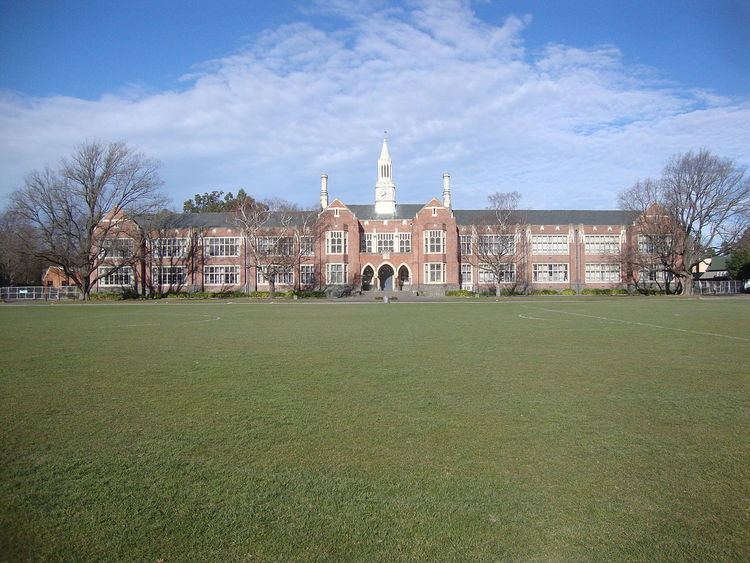 | ||
There are 152 schools in Christchurch, New Zealand's second most-populous city, serving approximately 57,500 primary and secondary school students. Most schools are large urban schools based in the city of Christchurch itself, including some of the largest in the country, with several small rural primary schools and a combined primary/secondary school on Banks Peninsula.
Contents
- Contributing primary schools Year 16
- Year 913
- Composite schools
- Former schools
- 2013 state school network review
- References
In New Zealand schools, students begin formal education in Year 1 at the age of five. Year 13 the final year of formal education. The thirteen years of formal education are generally broken up into primary education (Years 1 to 8) and secondary education (Years 9 to 13). In Christchurch, primary education is generally served by a combination of contributing primary schools (Years 1–6), full primary schools (Years 1–8), and intermediate schools (Years 7 and 8), while secondary schools serving Years 9-13 cater for secondary education. There are also a smaller number of combined intermediate and secondary schools serving Years 7-13; composite schools (combined primary and secondary schools) serving Years 1-13; special schools serving children with visual, hearing and intellectual impairments, learning difficulties and behaviourial problems; and teen parent units, providing education and support for teenage parents.
State schools are those fully funded by the government and at which no fees for tuition of domestic students (i.e. New Zealand citizens and permanent residents, and Australian citizens) can be charged, although a donation is commonly requested. A state integrated school is a former private school with a special character based on a religious or philosophical belief that has been integrated into the state system. State integrated schools charge "attendance dues" to cover the building and maintenance of school buildings, which are not owned by the government, but otherwise they like state schools cannot charge fees for tuition of domestic students but may request a donation. Private schools charge fees to its students for tuition, as do state and state integrated schools for tuition of international students. In Christchurch, approximately 77 percent of students attend state schools, 15.5 percent attend state integrated schools, and 7.5 percent attend private schools.
The roll of each school changes frequently as students start school for the first time, move between schools, and graduate or drop out. The rolls given here are those provided by the Ministry of Education, and are based on figures from July 2016. The Ministry of Education institution number links to the Te Kete Ipurangi page for each school.
Note that due to the effects of the 2011 Christchurch earthquake, some schools that were located in the central city and the eastern suburbs of the city have temporarily moved to other locations due to structural and/or land damage at their existing sites, and these changes are noted below. Throughout 2013, the state school network in Christchurch has been reviewed by the Government, with six schools due to close, six schools merging to form three schools, and another three schools adding years in January 2014.
Contributing primary schools (Year 1–6)
The 37 contributing primary schools cover the first six years of primary education, from age 5 to age 11. Students normally progress afterwards to an intermediate school, though some may go to a combined intermediate and secondary school. The majority are state schools, but there are two integrated contributing primary schools.
Year 9–13
The fourteen Year 9–13 secondary schools in Christchurch serve all five years of secondary education. They are a mixture of state, integrated and private schools, both coeducational and single sex.
Composite schools
The eleven composite schools in Christchurch each cover both primary and secondary education. The majority of them are private or state-integrated, although four are state schools, including two Kura Kaupapa Māori and an area school in Akaroa.
Former schools
2013 state school network review
During 2013, Education Minister Hekia Parata announced a multitude of proposed changes to the state school network in Christchurch. In addition, Parata announced changes to some schools in the Selwyn and Waimakariri Districts.
In January 2014, six schools closed, four schools merged into two, and three schools added years in the first phase of changes. A third merger between Lyttelton Main School and Lyttelton West School took effective on 5 May 2014.
The minister also confirmed and gazetted that Phillipstown School and Woolston School would merge on the Woolston site in January 2014. However, in June 2013, Phillipstown School asked the High Court for a judicial review, claiming Parata had acted illegally and made errors in her decision to close and merge the school. The review was accepted by the court, and the hearing began on 30 September 2013. On 10 October 2013, the High Court ruled in favour of Phillipstown School and overruled the Minister's decision. However, the merger went ahead, and on 2 February 2015, Te Waka Unua opened as the merged school on the site of the former Woolston School.
The following changes have been confirmed, but have yet to be gazetted.
These proposed changes have been announced, but have yet to be confirmed:
